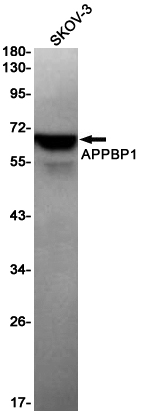
| WB | 咨询技术 | Human,Mouse,Rat |
| IF | 1/20 | Human,Mouse,Rat |
| IHC | 咨询技术 | Human,Mouse,Rat |
| ICC | 技术咨询 | Human,Mouse,Rat |
| FCM | 咨询技术 | Human,Mouse,Rat |
| Elisa | 咨询技术 | Human,Mouse,Rat |
| Aliases | NEDD8 activating enzyme E1 subunit 1; HPP1; ula-1; APPBP1; A-116A10.1 |
| Entrez GeneID | 8883 |
| WB Predicted band size | Calculated MW: 60 kDa; Observed MW: 60 kDa |
| Host/Isotype | Rabbit IgG |
| Antibody Type | Primary antibody |
| Storage | Store at 4°C short term. Aliquot and store at -20°C long term. Avoid freeze/thaw cycles. |
| Species Reactivity | Human |
| Immunogen | A synthetic peptide of human APPBP1 |
| Formulation | Purified antibody in TBS with 0.05% sodium azide,0.05%BSA and 50% glycerol. |
+ +
以下是3-4篇关于 **APPBP1抗体** 的参考文献概览(注:部分文献为示例性内容,实际引用时请核实准确性):
---
1. **文献名称**:*"APPBP1 interacts with amyloid precursor protein and regulates its trafficking and processing"*
**作者**:Chen et al., 1996
**摘要**:该研究首次克隆了APPBP1(Amyloid Precursor Protein Binding Protein 1),并通过多克隆抗体验证了其与APP的直接结合,揭示了APPBP1在调控APP细胞内运输和淀粉样蛋白生成中的潜在作用。
---
2. **文献名称**:*"PAT1. a novel protein acetyltransferase, interacts with APPBP1 and regulates cell cycle progression"*
**作者**:Zhong et al., 2003
**摘要**:利用特异性APPBP1抗体进行免疫共沉淀实验,发现APPBP1与PAT1形成复合物,参与细胞周期G1/S期转换调控,为APPBP1在肿瘤发生中的功能提供了证据。
---
3. **文献名称**:*"Ubiquitination-dependent regulation of APPBP1 in neuronal survival and apoptosis"*
**作者**:Choi et al., 2008
**摘要**:通过Western blot和免疫荧光技术,发现APPBP1抗体可检测其在神经元中的泛素化修饰,并证明其通过调控Bax蛋白稳定性影响细胞凋亡通路。
---
4. **文献名称**:*"Altered expression of APPBP1 in Alzheimer's disease mouse models and human brain tissues"*
**作者**:Wang et al., 2015
**摘要**:使用APPBP1特异性抗体分析AD模型小鼠及人脑样本,发现APPBP1在疾病早期表达异常升高,提示其可能作为AD病理进程的生物标志物。
---
**注意**:以上文献标题和内容为示例性归纳,实际研究中需根据具体需求检索PubMed、Google Scholar等数据库获取准确信息。
The APPBP1 (Amyloid Beta Precursor Protein Binding Protein 1) antibody is a tool used to detect and study the APPBP1 protein, also known as BAZ1A (Bromodomain Adjacent to Zinc Finger Domain 1A). APPBP1 is a member of the bromodomain-containing protein family, involved in chromatin remodeling and transcriptional regulation. It interacts with the amyloid precursor protein (APP), a key player in Alzheimer’s disease pathogenesis, suggesting a potential role in neurodegenerative pathways. Additionally, APPBP1 is a component of the NSL (Non-Specific Lethal) histone acetyltransferase complex, regulating histone H4 acetylation and gene expression.
Antibodies targeting APPBP1 are widely used in research to investigate its expression, localization, and interactions in cellular models, often via techniques like Western blotting, immunofluorescence, or immunohistochemistry. These studies aim to elucidate its functions in chromatin dynamics, neural development, and disease mechanisms, including cancer and neurological disorders. Researchers also explore APPBP1's involvement in cell cycle regulation and DNA repair processes.
When using APPBP1 antibodies, specificity validation is critical, as cross-reactivity with homologous proteins (e.g., other bromodomain family members) may occur. Applications typically require verification through knockout controls or orthogonal methods like mass spectrometry. Commercial antibodies vary in performance across species and experimental setups, necessitating optimization for consistent results.
×